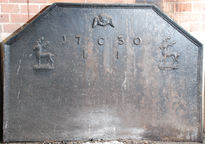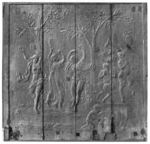-
1300
Description: Rectangular shape; twisted rope edging; top centre, a lion passant on the right and a lion passant guardant sinister on the left; in each top corner, a four-petalled Tudor rose; below each rose, two 'imps', one with right arm raised, the other with both arms lowered, the pair on the left facing to the right and the pair on the right facing to the left; below each lion, a crowned, four-petalled Tudor rose.
Notes: A spurious fireback based on, and probably adapted from, a 16th century English back, this and its copies include remodelled rope edging, lions and 'imp' figures, all probably dating from the restoration of Bunratty Castle in the 1960s.
Copies of this fireback are known.
- Decoration tags:
- rectangular (shape)
- rope (edging)
- carved stamps
- heraldic
- animals
- humans
- plants
Manufactured: in the mid-20th century in Ireland.
Current location: Bunratty Castle, Bunratty, County Clare, Republic of Ireland.
- Attached to series:
- Royal series
-
47
Description: Rectangular with canted top corners; ovolo-moulded edging (except base); top centre, cherub face and wings; below, date separated by initials in triad on either side of which a stag statant on a chapeau.
Notes: The cherub is similar, but not identical to those on a fireback, of 1713, from Ashburnham, and the layout and edging are also similar.
Inscription: 17 ICI [triad] 30
- Decoration tags:
- rectangular with canted top corners (shape)
- ovolo (edging)
- carved stamps
- individual letters
- individual numbers
- heraldic
- text
- animals
- humans
Manufactured: in 1730 possibly at Ashburnham Furnace in the Weald area of England.
Current location: in private hands, Cuckfield, West Sussex, England.
- Attached to series:
- Miscellaneous stamp firebacks
-
935
Description: Carved wooden fireback pattern. Rectangular shape with fillet edging; pictorial scene with three nymphs playing cymbals and tambourine, and dancing in the shade of two trees, with three satyrs play pipes behind; a jug stands on a pedestal; in the foreground a putto fills a jug from a barrel.
Notes: From the Fonderie Salan, Dammarie-sur-Saulx (Meuse).
- Decoration tags:
- rectangular (shape)
- fillet (edging)
- whole carved pattern
- planklines
- pictorial
- mythological
- humans
- plants
Manufactured: in the 18th century in France.
Current location: not known.
- Attached to series:
- Patterns
-
1064
Description: A rectangular field with a central circle containing a fouled anchor, the rope gathered in eleven loops around it; in the top spandrels the initials HH, on the left, and IH, on the right; below the circle, the initials IM inset in a square; on each side, a strapwork Ionic pilaster formed of alternate hollow squares, with a pyramidal infill in low relief, and hollow circles; outside each pilaster, a crouching stylised humanoid figure, facing inwards, disgorging a fructed vine; above the figures two opposed volutes, forming part of the edging; above the central field, a semi-circular compartment containing a bird, its wings inverted, and three hollow diamond shapes irregularly arranged; the date above the bird; protruding from the edging above each pilaster is a small, inward-facing scroll. Three vertical plank lines can be discerned, one in front of the right-hand figure, one through the I of the initials IH, and one to the right of the second H of the initials HH. The whole design is in low relief.
Notes: This is a reworking of a design seen on a fireback of 1608 (no. 585) though intentionally stylised. The decorative elements have yet to be fully interpreted; on the 1608 version the figures are fauns, the vines disgorged from their mouths being related to the 'green man' tradition associated with woodland spirits and symbolising resurrection, the latter echoed by the bird which, on the earlier version is a phoenix. However, in the form in which they appear on both firebacks they may be purely decorative devices. By contrast, the cabled anchor is the badge of the Lord High Admiral but in 1633 the office was vacant. The initials IM indicate that this is an early work by a prolific fireback pattern-maker more usually associated with the eastern Weald.
Inscription: 1633 / HH IH / IM
- Decoration tags:
- rectangular with round arch (shape)
- fillet (edging)
- whole carved pattern
- planklines
- pictorial
- mythological
- text
- animals
- humans
- plants
- objects
Manufactured: in 1633 in the Weald area of England.
Current location: Pound Farm, Common Road, Dunsfold, Surrey, England.
Citation: Wall, J. R. S., 20 May 1965, 'Wealden Fireback' [letter], Country Life, p. 1208.
- Attached to series:
- IM series
- Brede group
-
84
Description: Arched rectangular shape; ‘egg and dart’ ovolo moulding visible on top and sides; shield, helmet, crest, mantling and supporters of the Mohun family.
Notes: Cast from a finely carved pattern, the supporters denote these are the arms of a peer. The crest is: Gules, a maunch ermine, with a hand proper holding a fleur de lys or. Egg and dart moulding is rare and examples (at Maidstone and Burwash) may be the work of the same pattern maker. From Sidney Farm, Alfold, Surrey; Reginald Mohun (pron. Moon) of Dedisham, Slinfold, Sussex, was husband of Elizabeth Blounte of Dedisham c.1636. Bottom missing due to corrosion.
Copies of this fireback are known.
Arms: Mohun family, barons of Okehampton
- Decoration tags:
- rectangular with round arch (shape)
- ovolo, egg and dart (edging)
- whole carved pattern
- heraldic
- armorial
Manufactured: in the early- to mid-17th century in England.
Current location: Guildford Museum, Guildford, Surrey, England.
Museum number: G.7106 (part of the Guildford Museum museum group)
- Attached to series:
- Personal armorial firebacks
- Mohun series
-
355
Description: Rectangular joined to pediment by symmetrical scrolls; fillet edging with embattling inside; shield, helm, crest, supporters and mantling of the city of Bristol; date split by bottom of shield; inscription in an oval cartouche below shield.
Notes: Both '3's in the date are a substitution, with another casting suggesting an original date of 1614 or 1624. The pattern-maker was also responsible for carving royal coats of arms in three West Country churches and a small number of series of firebacks in the first quarter of the 17th century. A variant with side extension panels is no. 952.
Copies of this fireback are known.
Inscription: 16 33 / [ARMES] BRISTOLL
Arms: City of Bristol
- Decoration tags:
- rectangular with detached pediment (shape)
- fillet (edging)
- whole carved pattern
- individual numbers
- armorial
- text
Manufactured: in 1633 possibly in the Forest of Dean area of England.
Current location: Kenilworth Castle, Kenilworth, Warwickshire, England.
Museum number: 88278827 (part of the English Heritage museum group)
- Attached to series:
- Civic firebacks
- Bristol armorial group





